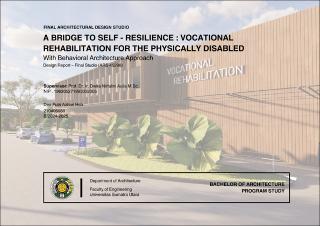| dc.contributor.advisor | Aulia, Dwira Nirfalini | |
| dc.contributor.author | Hsb, Dea Putri Azhari | |
| dc.date.accessioned | 2025-07-21T07:16:16Z | |
| dc.date.available | 2025-07-21T07:16:16Z | |
| dc.date.issued | 2025 | |
| dc.identifier.uri | https://repositori.usu.ac.id/handle/123456789/106010 | |
| dc.description.abstract | One of the buildings that requires facilities for people with special needs is
a Vocational Rehabilitation building. Vocational Rehabilitation is a series
of processes aimed at helping individuals with disabilities and disabilities
to obtain, maintain, or return to work, and engage in other productive
activities. Architectural design plays an important role in achieving the
success of Vocational Rehabilitation, especially through a behavioral
architecture approach. Behavioral architecture is an architecture whose
application always involves behavioral considerations in a design. In
vocational rehabilitation buildings, buildings designed with behavioral
architecture principles in mind can improve accessibility, encourage social
interaction, and create a more inclusive environment and support the
rehabilitation process for people with disabilities. | en_US |
| dc.language.iso | en | en_US |
| dc.publisher | Universitas Sumatera Utara | en_US |
| dc.subject | Behavioral Architecture | en_US |
| dc.subject | Disabled | en_US |
| dc.subject | Vocational Rehabilitation | en_US |
| dc.title | A Bridge to Self - Resilience : Vocational Rehabilitation for The Physically Disabled with Behavioral Architecture Approach | en_US |
| dc.type | Thesis | en_US |
| dc.identifier.nim | NIM210406088 | |
| dc.identifier.nidn | NIDN0027056302 | |
| dc.identifier.kodeprodi | KODEPRODI23201#Arsitektur | |
| dc.description.pages | 240 Pages | en_US |
| dc.description.type | Skripsi Sarjana | en_US |
| dc.subject.sdgs | SDGs 8. Decent Work And Economic Growth | en_US |


